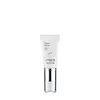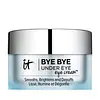What's inside
What's inside
 Key Ingredients
Key Ingredients

 Benefits
Benefits

 Concerns
Concerns

 Ingredients Side-by-side
Ingredients Side-by-side

Water
Skin ConditioningGlycerin
HumectantCoffea Robusta Seed Extract
Skin ConditioningSodium Hyaluronate
HumectantRhizobian Gum
Ascophyllum Nodosum Extract
Skin ConditioningChrysanthellum Indicum Extract
Skin ConditioningAsparagopsis Armata Extract
Skin ProtectingGlycosaminoglycans
EmollientSilica
AbrasiveSilica Silylate
EmollientHydroxyproline
Skin ConditioningTocopherol
AntioxidantMagnesium Ascorbyl Phosphate
AntioxidantAscorbyl Palmitate
AntioxidantDisodium Rutinyl Disulfate
AntioxidantSorbitol
HumectantLecithin
EmollientGlyceryl Stearate
EmollientButylene Glycol
HumectantGlyceryl Oleate
EmollientCarbomer
Emulsion StabilisingCaprylyl Glycol
Emollient1,2-Hexanediol
Skin ConditioningPropylene Glycol
HumectantAlcohol Denat.
AntimicrobialSodium Hydroxide
BufferingSorbic Acid
PreservativeTrisodium EDTA
Citric Acid
BufferingBenzyl Alcohol
PerfumingTriethanolamine
BufferingPotassium Sorbate
PreservativePhenoxyethanol
PreservativeChlorphenesin
AntimicrobialWater, Glycerin, Coffea Robusta Seed Extract, Sodium Hyaluronate, Rhizobian Gum, Ascophyllum Nodosum Extract, Chrysanthellum Indicum Extract, Asparagopsis Armata Extract, Glycosaminoglycans, Silica, Silica Silylate, Hydroxyproline, Tocopherol, Magnesium Ascorbyl Phosphate, Ascorbyl Palmitate, Disodium Rutinyl Disulfate, Sorbitol, Lecithin, Glyceryl Stearate, Butylene Glycol, Glyceryl Oleate, Carbomer, Caprylyl Glycol, 1,2-Hexanediol, Propylene Glycol, Alcohol Denat., Sodium Hydroxide, Sorbic Acid, Trisodium EDTA, Citric Acid, Benzyl Alcohol, Triethanolamine, Potassium Sorbate, Phenoxyethanol, Chlorphenesin
Water
Skin ConditioningCyclopentasiloxane
EmollientButylene Glycol
HumectantButyrospermum Parkii Butter
Skin ConditioningDimethicone
EmollientNiacinamide
SmoothingCetearyl Alcohol
EmollientPEG-40 Stearate
EmulsifyingPalmitic Acid
EmollientStearic Acid
CleansingPolysorbate 60
EmulsifyingMacadamia Ternifolia Seed Oil
EmollientCetyl Ethylhexanoate
EmollientGlyceryl Stearate
EmollientGlycerin
HumectantAcrylates/C10-30 Alkyl Acrylate Crosspolymer
Emulsion StabilisingCarbomer
Emulsion StabilisingSodium Hyaluronate
HumectantAcetyl Hexapeptide-8
HumectantCopper Gluconate
Skin ConditioningCollagen
MoisturisingTea-Cocoyl Glutamate
CleansingPalmitoyl Pentapeptide-4
Skin ConditioningCopper Tripeptide-1
Skin ConditioningBiotin
AntiseborrhoeicCaffeine
Skin ConditioningMagnesium Aspartate
Skin ConditioningZinc Gluconate
Skin ConditioningSodium Ascorbyl Phosphate
AntioxidantSodium Lauroyl Lactylate
EmulsifyingCeramide NP
Skin ConditioningCeramide AP
Skin ConditioningPhytosphingosine
Skin ConditioningCholesterol
EmollientXanthan Gum
EmulsifyingCeramide EOP
Skin ConditioningRetinol
Skin ConditioningTocopheryl Acetate
AntioxidantAscorbic Acid
AntioxidantAloe Barbadensis Leaf Extract
EmollientAnthemis Nobilis Flower Extract
MaskingCurcuma Longa Root Extract
MaskingSqualane
EmollientSpirulina Platensis Extract
Skin ProtectingAlgae Extract
EmollientCucumis Sativus Fruit Extract
EmollientColloidal Oatmeal
AbsorbentPropylene Glycol
HumectantGlycyrrhiza Glabra Root Extract
BleachingCamellia Sinensis Leaf Extract
AntimicrobialLecithin
EmollientCaprylic/Capric Triglyceride
MaskingCreatine
Skin ConditioningSimmondsia Chinensis Seed Oil
EmollientVaccinium Angustifolium Fruit Extract
Skin ProtectingMaris Aqua
HumectantPanthenol
Skin ConditioningPolyglutamic Acid
Skin ConditioningMethionine
Skin ConditioningLysine
Skin ConditioningLeucine
Skin ConditioningHistidine
HumectantIsoleucine
Skin ConditioningArginine
MaskingDisodium EDTA
Polyacrylate-13
Polyisobutene
Polysorbate 20
EmulsifyingSorbitan Isostearate
EmulsifyingTromethamine
BufferingSorbitan Stearate
EmulsifyingBenzophenone-5
UV AbsorberCholesteryl Nonanoate
EmollientCholesteryl Isostearate
EmollientCholesteryl Chloride
Skin ConditioningPhenylalanine
MaskingThreonine
Valine
MaskingSaccharide Isomerate
HumectantTryptophan
MaskingElaeis Guineensis Butter
EmollientSorbitol
HumectantPolysilicone-11
Dimethicone/Vinyl Dimethicone Crosspolymer
Skin ConditioningPhenyl Trimethicone
Skin ConditioningCitric Acid
BufferingAlcohol
AntimicrobialPhenoxyethanol
PreservativeCaprylyl Glycol
EmollientEthylhexylglycerin
Skin ConditioningChlorphenesin
AntimicrobialPotassium Sorbate
PreservativeCI 42090
Cosmetic ColorantWater, Cyclopentasiloxane, Butylene Glycol, Butyrospermum Parkii Butter, Dimethicone, Niacinamide, Cetearyl Alcohol, PEG-40 Stearate, Palmitic Acid, Stearic Acid, Polysorbate 60, Macadamia Ternifolia Seed Oil, Cetyl Ethylhexanoate, Glyceryl Stearate, Glycerin, Acrylates/C10-30 Alkyl Acrylate Crosspolymer, Carbomer, Sodium Hyaluronate, Acetyl Hexapeptide-8, Copper Gluconate, Collagen, Tea-Cocoyl Glutamate, Palmitoyl Pentapeptide-4, Copper Tripeptide-1, Biotin, Caffeine, Magnesium Aspartate, Zinc Gluconate, Sodium Ascorbyl Phosphate, Sodium Lauroyl Lactylate, Ceramide NP, Ceramide AP, Phytosphingosine, Cholesterol, Xanthan Gum, Ceramide EOP, Retinol, Tocopheryl Acetate, Ascorbic Acid, Aloe Barbadensis Leaf Extract, Anthemis Nobilis Flower Extract, Curcuma Longa Root Extract, Squalane, Spirulina Platensis Extract, Algae Extract, Cucumis Sativus Fruit Extract, Colloidal Oatmeal, Propylene Glycol, Glycyrrhiza Glabra Root Extract, Camellia Sinensis Leaf Extract, Lecithin, Caprylic/Capric Triglyceride, Creatine, Simmondsia Chinensis Seed Oil, Vaccinium Angustifolium Fruit Extract, Maris Aqua, Panthenol, Polyglutamic Acid, Methionine, Lysine, Leucine, Histidine, Isoleucine, Arginine, Disodium EDTA, Polyacrylate-13, Polyisobutene, Polysorbate 20, Sorbitan Isostearate, Tromethamine, Sorbitan Stearate, Benzophenone-5, Cholesteryl Nonanoate, Cholesteryl Isostearate, Cholesteryl Chloride, Phenylalanine, Threonine, Valine, Saccharide Isomerate, Tryptophan, Elaeis Guineensis Butter, Sorbitol, Polysilicone-11, Dimethicone/Vinyl Dimethicone Crosspolymer, Phenyl Trimethicone, Citric Acid, Alcohol, Phenoxyethanol, Caprylyl Glycol, Ethylhexylglycerin, Chlorphenesin, Potassium Sorbate, CI 42090
Ingredients Explained
These ingredients are found in both products.
Ingredients higher up in an ingredient list are typically present in a larger amount.
Butylene Glycol (or BG) is used within cosmetic products for a few different reasons:
Overall, Butylene Glycol is a safe and well-rounded ingredient that works well with other ingredients.
Though this ingredient works well with most skin types, some people with sensitive skin may experience a reaction such as allergic rashes, closed comedones, or itchiness.
Learn more about Butylene GlycolCaprylyl Glycol is a humectant and emollient, meaning it attracts and preserves moisture.
It is a common ingredient in many products, especially those designed to hydrate skin. The primary benefits are retaining moisture, skin softening, and promoting a healthy skin barrier.
Though Caprylyl Glycol is an alcohol derived from fatty acids, it is not the kind that can dry out skin.
This ingredient is also used as a preservative to extend the life of products. It has slight antimicrobial properties.
Learn more about Caprylyl GlycolCarbomer is a polymer of acrylic acid. Its main role is to create a gel consistency.
A high amount of carbomer can cause pilling or balling up of products. Don't worry, most products contain 1% or less of carbomer.
Chlorphenesin is a synthetic preservative. It helps protect a product against bacteria in order to extend shelf life. In most cases, Chlorphenesin is paired with other preservatives such as phenoxyethanol and caprylyl glycol.
Chlorphenesin is a biocide. This means it is able to help fight the microorganisms on our skin. It is also able to fight odor-releasing bacteria.
Chlorphenesin is soluble in both water and glycerin.
Studies show Chlorphenesin is easily absorbed by our skin. You should speak with a skincare professional if you have concerns about using Chlorphenesin.
Learn more about ChlorphenesinCitric Acid is an alpha hydroxy acid (AHA) naturally found in citrus fruits like oranges, lemons, and limes.
Like other AHAs, citric acid can exfoliate skin by breaking down the bonds that hold dead skin cells together. This helps reveal smoother and brighter skin underneath.
However, this exfoliating effect only happens at high concentrations (20%) which can be hard to find in cosmetic products.
Due to this, citric acid is usually included in small amounts as a pH adjuster. This helps keep products slightly more acidic and compatible with skin's natural pH.
In skincare formulas, citric acid can:
While it can provide some skin benefits, research shows lactic acid and glycolic acid are generally more effective and less irritating exfoliants.
Most citric acid used in skincare today is made by fermenting sugars (usually from molasses). This synthetic version is identical to the natural citrus form but easier to stabilize and use in formulations.
Read more about some other popular AHA's here:
Learn more about Citric AcidGlycerin is already naturally found in your skin. It helps moisturize and protect your skin.
A study from 2016 found glycerin to be more effective as a humectant than AHAs and hyaluronic acid.
As a humectant, it helps the skin stay hydrated by pulling moisture to your skin. The low molecular weight of glycerin allows it to pull moisture into the deeper layers of your skin.
Hydrated skin improves your skin barrier; Your skin barrier helps protect against irritants and bacteria.
Glycerin has also been found to have antimicrobial and antiviral properties. Due to these properties, glycerin is often used in wound and burn treatments.
In cosmetics, glycerin is usually derived from plants such as soybean or palm. However, it can also be sourced from animals, such as tallow or animal fat.
This ingredient is organic, colorless, odorless, and non-toxic.
Glycerin is the name for this ingredient in American English. British English uses Glycerol/Glycerine.
Learn more about GlycerinGlyceryl Stearate is a mix of glycerin and stearic acid.
It is used to stabilize the mixing of water and oil ingredients. By preventing these ingredients from separating, it can help elongate shelf life. It can also help thicken the product's texture.
As an emollient, it helps soften skin and supports barrier-replenishing ingredients.
In cosmetics, Glyceryl Stearate is often made from vegetable oils or synthetically produced.
This ingredient may not be fungal-acne safe
Fun fact: The human body also creates Glyceryl Stearate naturally.
Learn more about Glyceryl StearateLecithin is a term for a group of substances found in the cell membranes of plants, animals, and humans. They are made up of mixture of phospholipids.
This ingredient has emollient and emulsifying properties.
As an emollient, lecithen helps soften the skin and creates a barrier to keep moisture in.
As an emulsifier, it also helps prevent water and oil ingredients from separating. Lecithin can also help ingredients be better absorbed by the skin.
This is because the phospholipids in lecithin produce liposomes. Liposomes help other ingredients get through the skin barrier.
Depending on the source of this ingredient, lecithin may not be fungal acne safe. This is because some sources of lecithin come from soybean oil, which may feed the malassezia yeast that feeds fungal acne.
We recommend reaching out to the brand you are purchasing from to inquire about the source of their lecithin.
Some other names for this ingredient include soy lecithin and deoiled soy lecithin.
Learn more about LecithinPhenoxyethanol is a preservative that has germicide, antimicrobial, and aromatic properties. Studies show that phenoxyethanol can prevent microbial growth. By itself, it has a scent that is similar to that of a rose.
It's often used in formulations along with Caprylyl Glycol to preserve the shelf life of products.
Potassium Sorbate is a preservative used to prevent yeast and mold in products. It is commonly found in both cosmetic and food products.
This ingredient comes from potassium salt derived from sorbic acid. Sorbic acid is a natural antibiotic and effective against fungus.
Both potassium sorbate and sorbic acid can be found in baked goods, cheeses, dried meats, dried fruit, ice cream, pickles, wine, yogurt, and more.
You'll often find this ingredient used with other preservatives.
Learn more about Potassium SorbatePropylene Glycol is an odorless, colorless liquid. As a humectant, it helps skin retain moisture. It also aids in delivering active ingredients.
Another role of this ingredient is preventing a product from melting or freezing. Propylene glycol also adds antimicrobrial properties to a product, elongating product lifespan.
This ingredient is considered an organic alcohol and commonly added into both cosmetics and foods.
Those with sensitive skin or conditions may develop a rash when using this ingredient.
Learn more about Propylene GlycolSodium Hyaluronate is hyaluronic acid's salt form. It is commonly derived from the sodium salt of hyaluronic acid.
Like hyaluronic acid, it is great at holding water and acts as a humectant. This makes it a great skin hydrating ingredient.
Sodium Hyaluronate is naturally occurring in our bodies and is mostly found in eye fluid and joints.
These are some other common types of Hyaluronic Acid:
Learn more about Sodium HyaluronateSorbitol is a sugar alcohol. It is a hydrating and moisturizing agent created from the reduction process of glucose.
Most sorbitol is usually made from potato starch. It is also found in fruits such as apples and pears.
As a humectant, Sorbitol helps draw water to the skin. This helps keep the skin hydrated. Sorbitol also helps create a thicker texture in products. You might find sorbitol in your toothpaste and other gels.
It is a non-irritating ingredient that is great for those with dry skin.
Sorbitol is a prebiotic. It helps promote the growth of healthy bacteria on your skin. The bacteria on your skin form a microbiome. This microbiome helps protect your skin from infection and harmful bacteria.
Learn more about SorbitolWater. It's the most common cosmetic ingredient of all. You'll usually see it at the top of ingredient lists, meaning that it makes up the largest part of the product.
So why is it so popular? Water most often acts as a solvent - this means that it helps dissolve other ingredients into the formulation.
You'll also recognize water as that liquid we all need to stay alive. If you see this, drink a glass of water. Stay hydrated!
Learn more about Water